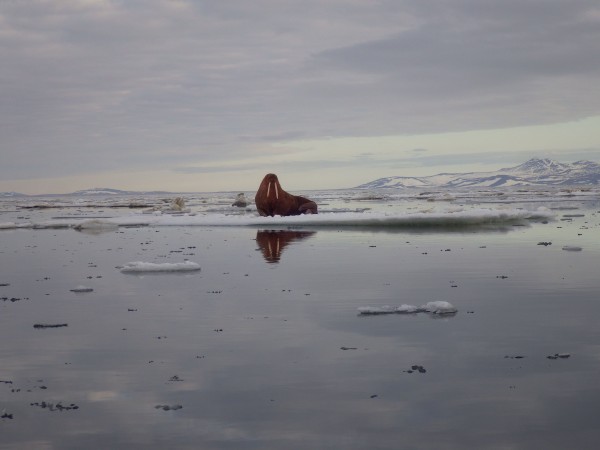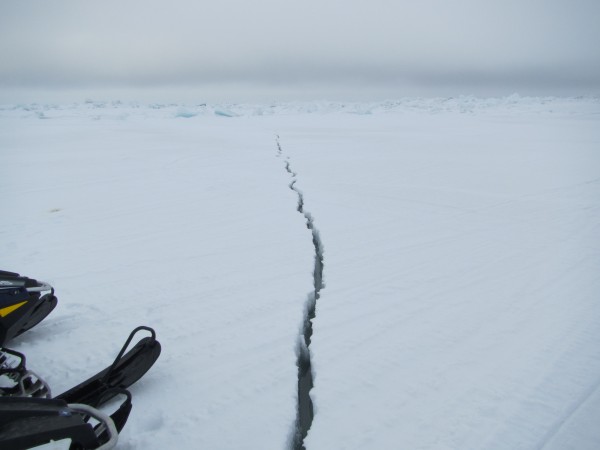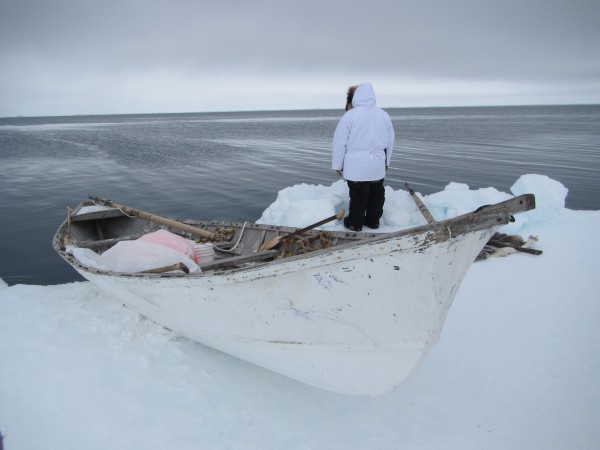Indigenous science guides university sea ice, climate change research
July 9, 2015
Diana Campbell
907-474-5229

My mother had so much to tell us about the taiga forest that she took my brothers and me into the woods during the summer when we were children. “Chew this,” she’d say, handing us hard chunks of spruce sap. “It’s gum.” Or “Don’t pick all the flowers,” she’d say. “Don’t pick all the berries. Save some for others and for them to come back next year.”
Mom was Alaska Native, and it was her job to tell us about the land. Because of this, we knew which plants were good to eat or had good berries. One thing eluded her, though. She was always trying to make a willow flute just like her father made her when she was a girl. She never could figure it out.
My grandfather died when Mom was 8 years old, so we couldn’t ask him. But he did tell us because he helped a scientist. More on that later.
Generations of explorers, researchers and scholars coming to Alaska for study have depended upon their Native informants. For example, in the early days of the University of Alaska Fairbanks, Lawrence Irving, who founded the Institute of Arctic Biology, had a close bond with Simon Paneak, of Anaktuvuk Pass.
It hasn’t always been a mutually beneficial relationship between informants and researchers. A story I’ve heard many times is how scientists go into a community, conduct their study and leave, never to come back. They go on to earn Ph.D. or master's degrees, publish their findings in scholarly journals and build careers. The people left behind have no idea what’s been said about them, and their lives aren’t bettered by the visit.
UAF has a history of trying to change that dynamic, in part by considering their Alaska Native informants as co-researchers. A group of scientists at UAF's Geophysical Institute are building relationships with the people who live with the ice and snow they study.
“A satellite image doesn’t tell us details of what the ice is doing,” said Mette Kaufman, a UAF research technician for SIZONet Local Sea Ice Observation Program. Indigenous people, particularly elders, have generations of knowledge about sea ice, she said. Their information adds to the larger picture of what’s happening in the Arctic.

SIZONet Local Sea Ice Observation Program
Hajo Eicken came from Germany to the Geophysical Institute because he wanted to be in a place where people live with sea ice.
He’s been here about 10 years and was a leader in the founding of SIZONet, an interdisciplinary project for observing seasonal ice in the context of environment.
“The Inupiat and the Yup’ik have developed a very intimate relationship with sea ice cover,” Eicken said in an interview by Arctic Stories. “And as a result, they have a very deep and, in many ways, a different knowledge of the ice cover than someone like I would, who has university training.”
Joining the two perspectives gives a better picture of what’s happening in the Arctic and is one of the purposes of the SIZONet Local Sea Ice Observation Program, Kaufman said. They depend on observers from Western Alaska coastal communities to report what’s happening with sea ice, as well as the environment, when they go whale hunting. The local observers send their reports, sometimes with photos, to a website. Kaufman tags observations by theme.
Bowhead whale hunting happens in the spring when whales are migrating north. Inupiat whale hunters start building trails on the ice to the open water in February or March, said Billy Adams, co-captain of the Ana’i Crew of Barrow. They watch the ice freeze up in October until whaling season in April or May. They know it intimately.
“We watch how the ice is being formed,” Adams said. “You have to know a lot of things. It takes many years to learn something and work with it.”
Once the whalers catch their whale, they need a safe piece of ice to drag the beast onto for all the whaling crews and the community to butcher the whale. The ledge of ice also needs to be close to where the whale has been caught.
“We also teach our young children to come out to the landed whale,” Adams said. “Everyone in the community is allowed to help and get a share of the whale.”
For generations, Inupiat whale hunters talk to neighboring whale hunters about what the ice and whales are doing. Telling a scientist is the same thing, Adams said.
“We call that tusaaugak or qangiqsiuq, asking for understanding,” he said. “Everybody has to learn.”

“The melt water on top has drained out as expected, so it will be no problem for your equipment out in front of Niksiurag,” Adams wrote on the SIZONet website June 4. “We call this draining of meltwater ‘kinniqtit.’ It is time to travel or go back whaling on the sea ice.”
Sea Ice for Walrus Outlook
The Sea Ice for Walrus Outlook is associated with the whale/sea ice observations program but focuses on seal and walrus hunting conditions. Walruses also are hunted in the spring when their migration north takes place, said Olivia Lee, a research associate with the Geophysical Institute. Lee is a marine mammal biologist but is learning about sea ice from an indigenous perspective.
“Most of the sea ice has drifted past, and today, there is no pack ice visible,” wrote Winton Weyapuk from Wales. “Wales passengers flying from Nome ... reported seeing a large walrus herd on a ice-floe 20 miles southeast by Cape York, which was the only piece of ice available for them here.”
Lee said that kind of detail and context couldn’t be found in a typical scientific observation using calculations, satellite imagery or remote field measurements.
“They have a community of experts with long-term, location-specific knowledge of sea ice which allows them to put current conditions in context with the past,” Lee said.
Locals and scientists have interest in sea ice but for different reasons, Weyapuk said.
“Scientists see sea ice in relation to their studies and subsistence hunters from the perspective of safety,” he said.
The browning of the Arctic
The Arctic is greening, scientists have found. That’s because sea ice decline and warming trends are contributing to new vegetation in the Arctic, said Uma Bhatt, an associate professor in remote sensing at the Geophysical Institute.
Greening except for the Yukon-Kuskokwim Delta in Alaska. Satellite data suggest vegetation there is browning. Bhatt and Ph.D. student Peter Bieniek sought help from Yup’ik elders who live in the area.
They worked with Ann Fienup-Riordan, a well-known Yup’ik cultural expert, and the Calista Elders Council in Bethel. The elders invited Bhatt and Bieniek to come and talk to them. First Bhatt and Bieniek wanted to know if the land was indeed browning and then if the elders had an idea why. An interpreter translated their questions into Yup’ik.
The elders sat in a circle and discussed the situation. Yes, vegetation was browning, they said. They thought perhaps it was the presence of salt in the air from the ocean.
Furthermore, berries were ripening sooner and not as good. Some reported the berries were salty.
“They were really scholarly elders,” Bhatt said. “They really thought this through. They are the professors of their culture.”
Bieniek said the satellite data was showing less snow cover. Perhaps that was causing tundra plants to die. Clearly, the problem is complicated, he said.
Bhatt and Bieniek are waiting to hear if a grant proposal will be funded so they can continue their work on the delta. Developing relationships for science collaboration with indigenous people is a long process and dependent on funding.
“We don’t want to be like those who show up, take what we want and leave,” Bhatt said. “We all have to work together to understand the Earth.”
And that flute my mother always wanted to learn how to make? In 1932, Cornelius Osgood, a Yale University anthropologist, came to Alaska to study the Gwich’in, then known as the Kutchin. My grandfather, John Fredson, was his guide and interpreter and one of his informants. Osgood wrote a book called “Contributions to the Ethnography of the Kutchin.” I grew up with my grandfather’s copy of the book in our home.
One day, I was skimming through it and I found the instructions on how to make the willow flute. The trick is to use willow harvested in spring when the sap is running and the bark slips off.
Mom would have liked that.
Diana Campbell is a writer for the Geophysical Institute at the University of Alaska Fairbanks. She is Gwich’in and Alutiiq and has been working in science communication for more than nine years. This column is free in cooperation with the UAF research community.



